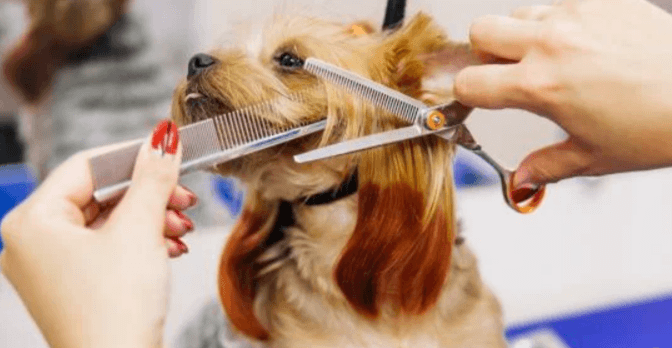How to Choose the Right Pet Groomer

Choosing the right pet groomer is an important decision for any pet owner. Grooming is not just about making your pet look good; it’s essential for their overall health and well-being. A skilled and experienced groomer can help maintain your pet’s coat, skin, nails, and ears, preventing potential health issues and ensuring they feel their best. With so many groomers available, finding the right one for your pet’s specific needs can be challenging. This article will guide you through the key factors to consider when choosing the right pet groomer, helping you make an informed decision that ensures your pet receives top-quality care.
Assess the Groomer’s Qualifications and Experience
The first step in choosing the right pet groomer is to assess their qualifications and experience. While pet grooming is not as strictly regulated as other professions, many groomers pursue certification or training programs to hone their skills. Look for a groomer who has received formal training from a recognized grooming school or has certification from a professional organization like the National Dog Groomers Association of America (NDGAA) or the International Society of Canine Cosmetologists (ISCC).
Experience is also crucial. An experienced groomer is more likely to handle a variety of breeds and temperaments effectively. They will have a better understanding of breed-specific grooming needs and be more adept at managing anxious or difficult pets. Ask how long the groomer has been in business and if they have experience with your particular breed or type of pet.
Visit the Grooming Facility
Before making a decision, visit the grooming facility in person. This allows you to assess the cleanliness, safety, and overall environment where your pet will be groomed. A clean, well-maintained facility is a good indicator of a professional operation. Pay attention to the grooming area itself—are the tools and equipment clean and well-organized? Are the kennels or holding areas sanitary and comfortable?
Also, observe how the groomer and staff interact with the animals. Are they gentle and patient? Do they seem knowledgeable and confident in handling pets? The atmosphere should be calm and stress-free, with safety protocols in place to prevent injuries. A facility that takes cleanliness and safety seriously is more likely to provide high-quality care for your pet.
Ask About Grooming Services Offered
Different pets have different grooming needs, so it’s important to choose a groomer who offers the services your pet requires. Common grooming services include bathing, brushing, haircuts, nail trimming, ear cleaning, and teeth brushing. Some groomers also offer specialized services such as de-shedding treatments, flea and tick treatments, and skin and coat conditioning.
Discuss your pet’s specific needs with the groomer and ask if they provide the services required. For example, if your pet has a long or double coat that requires regular de-shedding or mat removal, ensure that the groomer is skilled in these techniques. If your pet has sensitive skin or allergies, ask if the groomer can use hypoallergenic or medicated shampoos.
Additionally, inquire about any add-on services that might benefit your pet, such as nail grinding instead of clipping for smoother edges, or specialized dental care. A groomer who offers a comprehensive range of services is better equipped to meet your pet’s unique grooming needs.
Consider the Groomer’s Handling Techniques
How a groomer handles pets is critical to the grooming experience. Pets can be anxious or nervous during grooming, especially if they are not used to the process. A skilled groomer should be able to manage your pet’s anxiety and ensure that the grooming experience is as stress-free as possible.
Ask the groomer about their handling techniques and how they manage nervous or difficult pets. Do they use calming techniques, such as speaking softly, using gentle restraint, or offering breaks during the grooming session? Avoid groomers who use rough handling or who seem impatient with pets. It’s important that your pet feels safe and comfortable throughout the grooming process.
You might also want to ask about the groomer’s policy on sedation. While some pets may require mild sedation for grooming due to extreme anxiety or aggression, this should only be done under the supervision of a veterinarian. A good groomer will work with you to find the best approach for your pet without resorting to unnecessary sedation.
Check References and Reviews
One of the best ways to gauge the quality of a pet groomer is by checking references and reading reviews from other pet owners. Ask the groomer for references from clients who have pets similar to yours in terms of breed and grooming needs. Speaking with other pet owners about their experiences can provide valuable insights into the groomer’s skill, professionalism, and how they treat animals.
Online reviews are also a useful resource. Look for reviews on sites like Google, Yelp, or specialized pet care platforms. Pay attention to both positive and negative feedback, and look for patterns in the reviews. Consistently positive reviews that mention specific qualities, such as gentle handling, attention to detail, and excellent customer service, are good indicators of a reliable groomer.
If you see negative reviews, take note of any recurring issues, such as poor communication, rough handling, or unsanitary conditions. However, keep in mind that a few negative reviews are not uncommon and should be weighed against the overall trend of feedback.
Understand Pricing and Policies
Grooming costs can vary widely depending on the services provided, the size and breed of your pet, and the groomer’s location and experience. It’s important to understand the pricing structure before committing to a groomer. Ask for a detailed breakdown of costs, including any additional fees for specific services like nail grinding, teeth brushing, or de-shedding treatments.
In addition to pricing, inquire about the groomer’s policies on cancellations, late arrivals, and emergency situations. What happens if you need to cancel or reschedule an appointment? Is there a fee for late cancellations? Understanding these policies upfront can help you avoid any surprises later on.
It’s also worth asking about the groomer’s policy on handling emergencies. In the rare event that your pet has a medical emergency during grooming, how will the situation be handled? Will the groomer contact you immediately, and are they prepared to transport your pet to a veterinarian if necessary?
Consider Convenience and Location
Convenience is another important factor when choosing a pet groomer. Consider the groomer’s location relative to your home or work, as well as their hours of operation. A conveniently located groomer with flexible hours can make it easier to schedule regular grooming appointments, which is especially important if your pet requires frequent grooming.
Some groomers also offer mobile grooming services, where they come to your home to groom your pet. This can be a great option for pets who are anxious about traveling or for owners who prefer the convenience of at-home grooming. Mobile grooming can reduce the stress associated with taking your pet to a grooming facility and often provides a more personalized experience.
Evaluate the Groomer’s Communication Skills
Good communication is key to a successful relationship with your pet groomer. Your groomer should be willing to listen to your concerns, answer your questions, and discuss your pet’s specific grooming needs. They should also be transparent about their process, explaining what each service involves and why it’s important for your pet’s health.
After each grooming session, a professional groomer will provide feedback on how your pet did during the session, any issues they noticed (such as skin irritations or ear infections), and any recommendations for at-home care. This ongoing communication ensures that you are informed about your pet’s health and grooming needs, allowing you to take better care of your pet between grooming appointments.
Ensure Your Pet’s Comfort and Safety
Your pet’s comfort and safety should be the top priority when choosing a groomer. Observe how the groomer interacts with your pet during the initial consultation or visit. Do they take the time to let your pet get comfortable before starting the grooming process? Are they patient and gentle in their approach?
Safety measures are also crucial. The grooming facility should have protocols in place to prevent accidents, such as secure harnesses or restraints on grooming tables, non-slip mats, and properly sanitized tools. Additionally, the groomer should be knowledgeable about how to safely handle pets during grooming tasks, such as nail trimming, which can be particularly sensitive for some animals.
If your pet has any special needs, such as a medical condition or mobility issues, discuss these with the groomer to ensure they are equipped to handle them appropriately. A good groomer will be willing to accommodate your pet’s specific needs and take extra precautions to ensure their safety and comfort.
Start with a Trial Grooming Session
Once you’ve done your research and feel confident in your choice, consider scheduling a trial grooming session. This allows you to assess how your pet responds to the groomer and the overall grooming experience. During the trial session, observe how the groomer handles your pet, how your pet behaves before, during, and after the grooming, and whether the final results meet your expectations.
After the session, pay attention to your pet’s behavior. Are they calm and relaxed, or do they seem stressed and anxious? A positive grooming experience should leave your pet looking and feeling good, not traumatized or uncomfortable.
If the trial session goes well, you’ve likely found the right groomer for your pet. If not, don’t hesitate to try another groomer until you find the one that best suits your pet’s needs.
FAQs
1. How often should my pet be groomed?
The frequency of grooming depends on your pet’s breed, coat type, and lifestyle. Most dogs benefit from grooming every 4-6 weeks, while cats may require less frequent grooming.
2. What should I bring to my pet’s grooming appointment?
Bring your pet’s vaccination records, any specific grooming instructions, and any special products your pet requires, such as medicated shampoos







